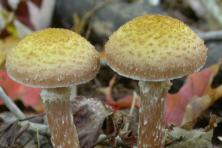Door to Nature: The Season’s Last Flower
- Share
- Tweet
- Pin
- Share

I never heard of the liquid that Roy used on his face after he shaved. It was an astringent called “witch-hazel.” He said it soothed his skin and was not expensive. His father was a barber in Kewaunee for 60 years and it was in regular use there.
Witch hazel is a shrub that usually grows 12 to 15 feet, but can be considered a tree because some we’ve seen were nearly 30 feet tall. Its scientific name is Hamamelis virginiana. The genus name comes from the Greek hama, meaning “together,” and melis refers to the fruit. This name origin refers, in part, to the shrub’s production of flowers and fruit at the same time. The species name simply means it was originally discovered in Virginia.
This plant is the last one to flower, often in late October to early November. Its native range is from the western Great Lakes down to Texas and through much of the eastern United States.
If you look up the name “witch hazel,” you may find it spelled as witch-hazel. Another name for the plant is “winterbloom.” It was the early American settlers who saw a similarity of our plant to their old-country, witch-elm, or “Wyche-hasil.” You can read more about this in Edwin Way Teale’s book, Wandering Through Winter. Look in the chapter entitled “The Witch-Hazel Gatherer.”
“Wyche” can be traced to weak, drooping, or pliant – the nature of the branches of both the witch elm and witch hazel. In fact, the witch elm common in England and Ireland is also called “tabletop elm” due to its drooping, flat-topped crown.
There are tales of people bringing large bouquets of witch hazel flowers, along with the many nut-like seed pods, into their homes. Slowly, the seed pods dried and suddenly, sometimes in the middle of the night, the people were awakened to a veritable bombardment of seeds hitting the walls, windows and ceilings, like light artillery in action!
The dark brown, quarter-inch-long streamlined seeds mature over winter and are ripe by the following fall. Decorated with a white dot, they lie in very close-fitting cells. There are two seeds in each hard, woody capsule. As they dry, the edges of the “cups” curve inward with great force, expelling the projectile-shaped seeds explosively.
Apparently, the soothing effects of the alcoholic solution of a distillate of witch hazel bark was quite standard in many turn-of-the-century households. It was the perfect remedy for cuts, bruises, stiff muscles, sprains, burns, frostbite, sunburn, chapped skin – and “you name it.” The inner bark is the part of the plant that is astringent.
This widespread, ornamental, shrubby tree has downright intricate and beautiful flowers. At first glance, the narrow, twisted yellow petals make the flower appear to be crumpled. A closer look with a magnifying lens reveals a very sticking, four-parted flower. The fact that there are sometimes three to five blossoms in a cluster imparts a bit of a ragged fringe-like appearance to many flowering twigs.
Forked branches of the witch hazel were frequently used years ago as divining or dowsing rods, also called “witch sticks,” for locating underground sources of water. Roy and I went with his father many years ago to a farm west of Kewaunee. The owner of the farm showed us how he could detect water below the ground using a witch hazel branch. He gave Roy a turn, and his father tried with the dowsing rod, but neither had the ability to make the stick bend.
Then he gave me the forked branch and – voilá – success! I was able to find water. I held the branch very tightly in my hands with the stick pointing upward. When I came near an underground water source, the stick quickly turned down to the earth. I held it so tightly that I felt my skin twisting as the rod moved downward. So, I was proclaimed a Water Witch.
When planting a witch hazel tree, it is best to place it on the north side of a building in the shade. The many-stemmed tree does not thrive in full sun. The flowers don’t develop until the tree is at least six years old.
There is another choice for your yard, and that is the Chinese species, Hamamelis mollis, especially when grafted to the root stock of the native American plant, H. virginiana. I presume that is the way the Chinese species is treated before being sold in the US as decorative landscape material. Check with your local tree nursery.
Enjoy a walk in the woods on a gorgeous autumn day, and look for the last blooming flower of the year!




